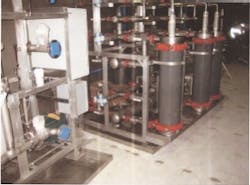Wastewater treatment plant expansion completed in Johnson County
"Removal of phosphorus and nitrogen will now carry benefits all the way to the Gulf of Mexico, where government and environmental agencies strive to reduce problems related to oxygen deficiency," said John O'Neil, general manager of JCW.
Transformation of the Middle Basin treatment plant into a larger plant with improved wet-weather treatment and odor control as well as biological nutrient removal (BNR) capabilities was completed this summer. The expansion increased plant capacity from 12 to 14.5 million gallons per day (mgd); the plant was previously running at a full capacity of 12 mgd through facilities originally designed to operate at 9 mgd. JCW was able to maintain operations throughout construction, which was led by BRB Contractors Inc.
The Middle Basin treatment plant is among the first in the Kansas City, Mo., metropolitan area to incorporate BNR technology to reduce its discharge of phosphorus and nitrogen, with JCW's Blue River Main Wastewater Treatment Plant (WWTP) credited as the first application of BNR in the area.
Because the nature of the organic matter in municipal wastewater is not always ideal for biological nutrient removal, carbon augmentation is often used to improve biological nutrient removal performance. After considering such carbon augmentation strategies as changing the nature of the organic matter through fermentation or adding external chemicals or organic waste products, JCW selected fermentation as the most cost-effective solution.
Improvements to existing wet-weather storage facilities were designed to reduce odor potential and minimize wet-weather related excess flows from the plant's equalization basins discharging into the receiving stream by 90 percent.
Because the Middle Basin treatment plant is located near commercial and residential developments, all new and modified treatment facilities have odor control systems. Existing odor containment, ventilation and treatment facilities were improved and expanded as part of the project.
###
